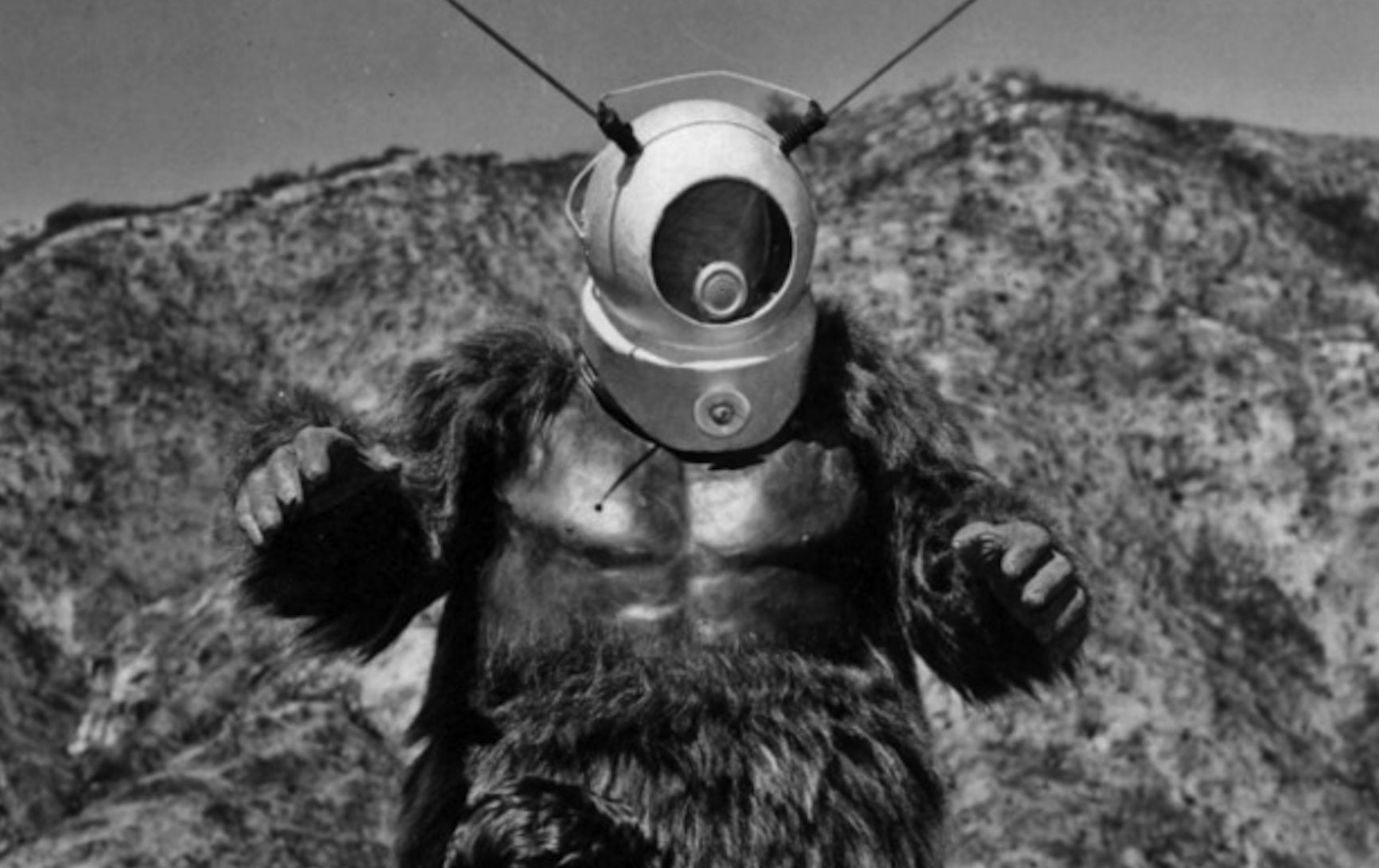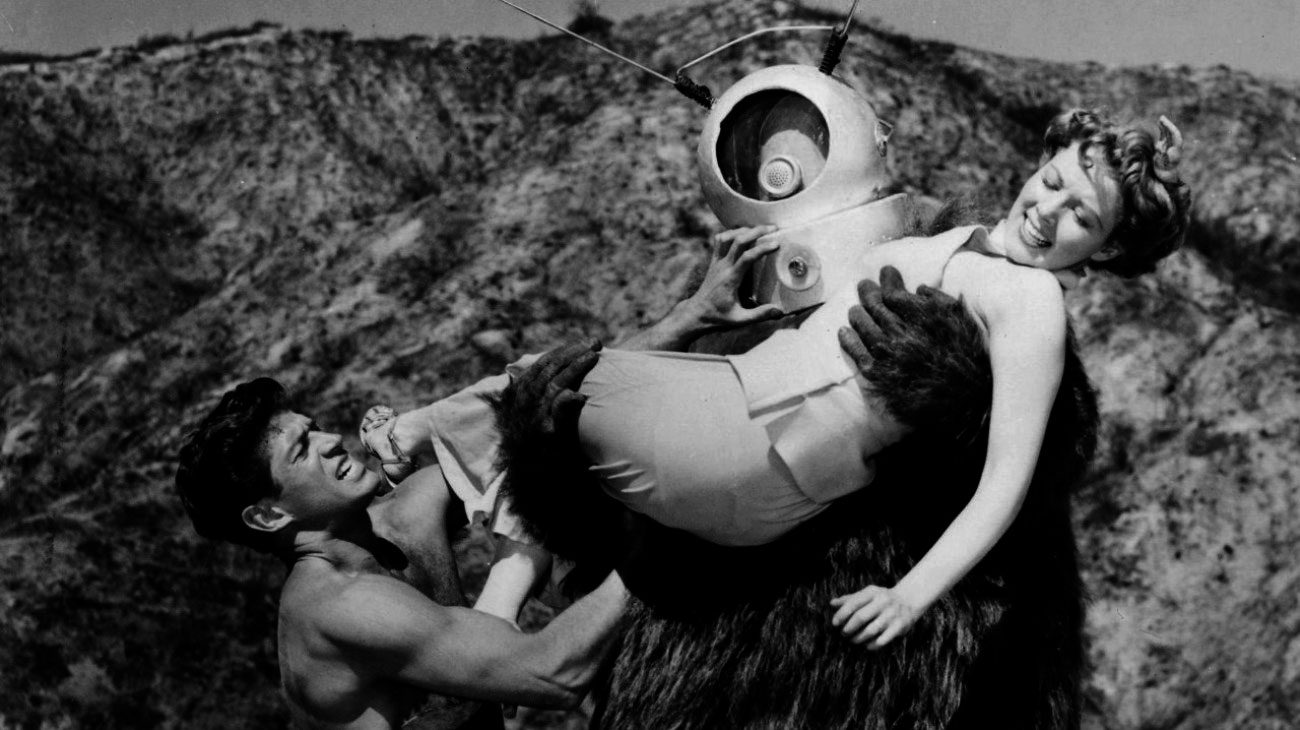Robot Monster, the gloriously stupid movie from screenwriter Wyott Ordung and director Phil Tucker, is legendary amongst shitty movie fans. And it’s for one single reason. This is the monster:

It’s a robot, but it doesn’t look like any robot that viewers know. Shot in a matter of days for somewhere around $16,000, there wasn’t enough time or money for the crew to come up with a decent robot costume. According to the internet, so it must be true, Tucker hired a friend of his, George Barrows, to play the robot, partly because he had a gorilla suit they could use. This has the smack of apocrypha, but it’s the type of guerilla filmmaking (heh-heh) I love. Whether this story be truth or fiction, what ended up on the screen cannot be denied. That is one of the most ridiculous movie monsters there has ever been.
Released in late June, 1953, Robot Monster follows young Johnny (Gregory Moffett), and his family as they try and avoid the attentions of the robot, who is called Ro-Man. Ro-Man is an alien being who just arrived on Earth and slaughtered civilization. A viewer could be forgiven if they didn’t know this, however. The introduction of Ro-Man is a whipsaw of bad pacing and re-used footage.
Johnny is looking around Bronson Canyon (get used to seeing this location) when, all of a sudden, at the mouth of the iconic cave, there’s a whole bunch of lightning Foley effects and flashes. Then, for reasons that have no viable explanation, viewers are treated to footage of lizards fighting lifted from 1940’s One Million B.C., and stop motion shots from Lost Continent. Near the end of the film, Tucker has the audacity to use this same footage again. It has nothing to do with the plot, and is shameless padding of the running time. This flick needed it, though. Even with all the footage from other movies, this dog still clocks in at only 62 minutes.
Lest readers get the wrong idea from my harsh words, that 62 minutes is packed full of wonderful absurdity. Yes, it’s egregious that Tucker would use footage from other movies (footage from Rocketship X-M, Flight to Mars, and Captive Women can also be seen), and it’s even more egregious that said footage doesn’t make any sense. But, look at this monster:

I can’t hate any movie that has that as the monster.
Anyway, after the non-sensical lizard fight, Ro-Man emerges from the cave around a litany of science stuff. One critical piece of equipment is a bubble machine. Ro-Man then contacts his boss, Great Guidance, on Ro-Skype. Great Guidance is just Barrows in his gorilla suit, only with a slightly different helmet. Ro-Man tells Great Guidance (both characters are voiced by blacklisted actor John Brown) that he has succeeded in destroying all humans on planet Earth, paving the way for colonization. Great Guidance has better sensory equipment, however, and informs Ro-Man that there are still a handful of survivors left on Earth, and Ro-Man must hunt them down.
The scenes where Ro-Man and Great Guidance talk together are incredible. The monster costumes have no faces, really, so Barrows pantomimed during the dialogue. The way he moves his body and arms, and the sound of Brown’s dubbing, evokes kung fu flicks, believe it or not.
Meanwhile, Johnny returns to his family, and we learn that the patriarch, The Professor (John Mylong), has set up a special electric field that keeps Ro-Man from locating them. The family is also immune to Ro-Man’s death ray, because they all took an experimental vaccine whose side effect just happened to be immunity from the ray. That’s some pretty incredible technology.
The remainder of the flick features Ro-Man wandering all over Griffith Park looking for Johnny and his family in that ridiculous getup, and having occasional conversations on that Ro-Skype  machine with both Great Guidance and the surviving humans. Other than that, not much else happens in this flick (remember, 62-minute running time and a poverty-stricken budget).
machine with both Great Guidance and the surviving humans. Other than that, not much else happens in this flick (remember, 62-minute running time and a poverty-stricken budget).
What makes the film work is the total package. Tucker was an incompetent filmmaker. He struggled with the simplest of storytelling tasks, and had trouble holding together the narrative. The music is overwrought and just…more…than the film needed. It was composed by Elmer Bernstein, who was having his own issues with blacklisting at the time, and provides bombast.
The whole movie plays out like a weird fever dream, or the type of movie that a ten-year-old would make. That’s not being facetious. It has the same outlandish plot jumps and lack of focus that I remember from my childhood dabblings in fiction. It turns out there’s a reason for that. I’ll explain, but it spoils the ending, so be warned before reading further. Having foreknowledge risks ruining the experience. This shitty flick heavily rewards a first, blind watch.
It was all a dream. That’s right. The film’s confusing turn when Ro-Man is introduced is explained by Johnny being knocked on the head and slipping into a dream. Ro-Man isn’t real, and everyone on Earth is still alive.
Was Tucker a much better filmmaker than I thought? It’s possible. When considering the film takes place in the mind of a child, all that plot stuff that looks incompetent begins to make sense. The movie is still shitty, to be sure. But it also has some cleverness once one knows what Tucker was trying to accomplish.
Of final note is the cast. They stink. I won’t pick on Moffett or the young girl that plays his sister (Pamela Paulson). It’s the adults that will try one’s patience. Especially Claudia Barrett as The Professor’s eldest daughter, Alice. Barrett is an ACTRESS, and wins the canned ham for this flick.
Robot Monster is a hell of a watch for a shitty 1950s monster flick. It’s absurd, outlandish, cheap, and any other shitty superlative one can come up with. Tucker didn’t have two nickels to rub together, and it shows. His response was to go all-in on the stupid. It worked. Robot Monster flies into the top twenty on the Watchability Index, nestling in at #11 between Rambo: First Blood Part II and Maximum Overdrive. Check it out.
